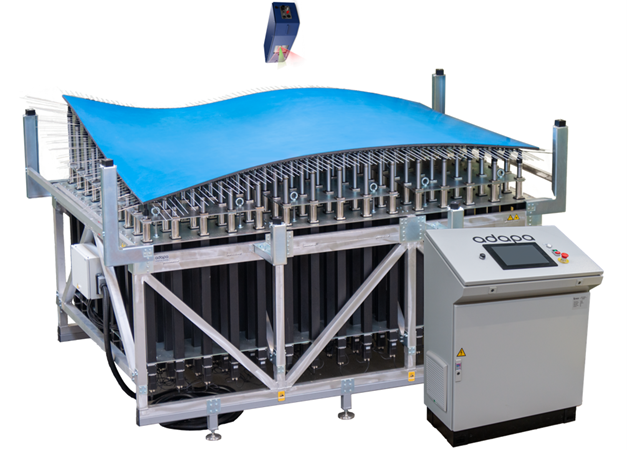THE ADAPTIVE MOULD FOR INDUSTRY 4.0
Past Industrial Development Focus
Adapa A/S has evaluated the Industry 4.0 readiness of their adaptive mould technology based on Boston Consulting Groups report describing “The Nine Pillars of Technological Advancement”. Aalborg University has reviewed Adapa’s industry 4.0 evaluation, as part of Adapa A/S’ entering into participation in the INDUSTRY4.0 network Innovation Factory North, Aalborg University, Denmark.
Since the dawn of the Industrial Revolution ignited by the steam machine, industrial fabrication has become more and more automated, systematic, and uniform. The connection between automation, systems and uniformity is evident in construction and architecture. Handmade craftmanship of unique architecture from the past, is now dominated by industrialized uniform architecture. This is not only to drive down cost, but also to scale up fabrication to follow the rapid growth in population.

Present and Future of Industry 4.0
We are now well into the fourth wave of technological advancement; the rise of a new digital industrial technology known as Industry 4.0.
The transformation is in the construction and architecture industry is mainly driven by 3D CAD drawings, that allow the value chain to interact on each construction project.
Cloud based 3D drawings now make it possible to gather, analyze, plan, and execute fabrication based on one set of real-time data. As each specific part in the construction is defined in the 3D drawing, the data can trough interfaces be used to program automated machines.
This type of direct from 3D drawing to automated manufacture will increase productivity, quality, speed, and enable manufacture of customized constructions.
Adapa and “THE NINE PILLARS OF TECHNOLOGICAL ADVANCEMENT”
The adaptive moulds from Adapa are controlled by data input direct from architectural 3D files.
The technology allows a fully integrated, automated, and optimized production flow.
This leads to greater efficiencies and changing traditional production relationships among suppliers, producers, and customers – as well as between human and machine.

1. ADDITIVE MANUFACTURING
In contrary to machining (cutting) technologies, casting and shaping techniques are in general based on mould technologies.
As casting and shaping is material adding techniques, they by nature fall within the definition of additive manufacturing technologies. The traditional modern mould making process is to utilize machining, CNC cutting/milling, where mould material is removed to create the mould surface.
This means, that in practice it is questionable if traditional casting and shaping techniques fall within the additive manufacturing, if not utilizing either Additive Manufacturing in Tool and Mould Making (ettm.com) or Reconfigurable Tooling (compositesworld.com).
Adapa’s adaptive moulds are Reconfigurable Tools that can be used for additive manufacturing.
2. AUTONOMOUS ROBOTS
Adapa’s adaptive moulds are Human Machine Interface (HMI) operated based on Windows10 programming and contains 3 Industrial Robotic Features (computertechreviews.com).
Movement: The adaptive moulds automatically convert the 3D file to machine movement and position of the casting surface.
Autonomy: The adaptive moulds autonomously detects if the 3D surface can be created, conducts a self-calibration process, and detects if there are mechanical failures.
Information Collection: The adaptive moulds creates a log-file that can be used for documentation and assessment of tolerance-quality, process, and productivity.
3. AUGMENTED REALITY
In the additive casting or shaping process, Adapa’s adaptive moulds also guides the user in positioning casting sides, panels, fixtures, brackets, reinforcement etc. This is done automatically using Laser Guided Augmented Reality (laserfocusworld.com).
4. SIMULATION
Adapa’s own software Adapa Tools can as a plugin for Rhino 3D software, be used for simulating panelization of architecture and design, upfront of fabrication. This allows for optimization of the production process relative to Experimental Design for Product and Process Design (Montgomery, 1999) and fabrication planning relative to Just in Time Production (kanbanize.com).
5. HORIZONTAL AND VERTICAL SYSTEM INTEGRATION
Adapa’s adaptive moulds are controlled by the 3D surfaces that stem from Building Information Models (BIM sciencedirect.com) shared horizontally and vertically between architects, consultants, contractors, and suppliers.
6. THE CLOUD
During construction process the BIM model may be changed due to several factors. Adapa’s adaptive moulds enable real time adaptation to change, as the shape is created in 5 minutes based on the 3D file in the Cloud Based BIM (bimplus.co.uk).
7. BIG DATA AND ANALYTICS
BIM data is being used in the construction industry for process and cost optimization. Every project generates new data, and post-analysis of project data enables optimal processes for future projects. Adapa’s adaptive moulds ensures that data can be logged and shared for future industry optimization, trough BIM and Big Data for Construction Cost Management (researchgate.net).
8. THE INDUSTRIAL INTERNET OF THINGS
Adapa’s adaptive moulds are Industrial Smart Objects (ieeexplore.ieee.org) in such a way that they are intelligent programmed based on 3D data, controlled by Human Machine Interface and guides human interaction with Augmented Reality laser guidance.
9. CYBERSECURITY
When communicating or exchanging data trough of cloud-based systems or file sharing in general, cyber security needs to be addressed to protect critical industrial systems. Adapa’s adaptive moulds use Windows10 as programming software, ensuring standard protocols of communication and security, Building More Secure Devises with Windows 10 IoT (windows.com).
Review by Aalborg University
Aalborg University, Department of Materials and Production has entered into dialogue with Adapa regarding Industry 4.0. Based on this dialogue we are of the impression that Adapa works seriously with Industry 4.0 technologies in their product offerings.
The foundation of their solutions is 3D drawings of the product. From the 3D drawing, production data is generated, which is used to automatically configure the adaptive mould. In compliance with Industry 4.0, their solutions enable process integration from 3D drawings from the engineers or architects all the way to mould configuration in the production with the potential of further systems integration, e.g. handling robots, which either feed materials to the mould or removes the product after casting.
Their solutions have Wi-Fi connections, which makes file transfers possible with little effort. This also implies that in case a 3D file is altered by the designer/architect, Adapa’s moulding solution has the ability to read the file in the CAD software cloud, and make a modified mould within minutes. Their solutions collect data such as date, time of start and finish, operating time, which makes it easy for the owner of the mould to calculate overall equipment efficiency (OEE) of the process. Furthermore, their solutions create a unique ID of the product being produced, and pairs this to the other information such as operating time and mould installation, which makes it easy to go back and find information on the product in the future.
The company is currently working on integrating more Industry 4.0 specifications in their products in order to accommodate the requirements of tomorrow’s moulding industry.
The review was conducted by PhD scholars Maria Støttrup Schiønning Larsen and Andreas Kornmaaler Hansen.

